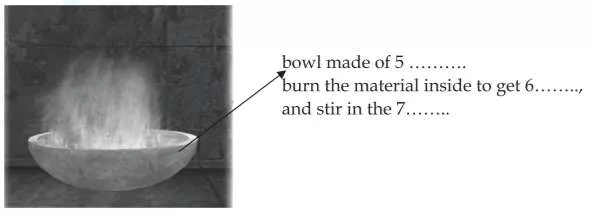Tattoo on Tikopia - IELTS Reading Answers
14 min read
Updated On
-
Copy link
Boost your IELTS Reading speed and accuracy with the passage, ‘Tattoo on Tikopia’. Tackle True/False/Not Given, Diagram Completion, and Table Completion questions while comparing yours with the correct answers to improve comprehension skills.
Table of Contents

Limited-Time Offer : Access a FREE 10-Day IELTS Study Plan!
The IELTS Reading passage, ‘Tattoo on Tikopia’, requires you to be able to read an essay and answer the different types of questions based on the essay at a brisk pace. To score well in the IELTS Reading section, you need to learn to evaluate the way you comprehend, interpret, and analyse written information within a limited timeframe of 40 minutes. This passage introduces you to anthropological concepts and descriptive language while trying to attempt different question types. By indulging yourself with such passages, you will develop the skills of critical reading, efficient time management, and infer meaning provided in the passage.
Connect with our band 9 IELTS Trainers to crack your IELTS Reading in no time! Book a FREE Demo.
Types of Questions in IELTS Reading Passage ‘Tattoo on Tikopia’
Knowing the types of questions lets you understand the specific skills which would be tested. Along with that, you can also go through the text for its meaning, quickly find the needed information, and focus on one type of question at a time. This will help in developing your skills to deduce meanings, especially when you encounter any new terms. Below are the three question types which you will need to answer for the passage, ‘Tattoo on Tikopia’.
- IELTS Reading True False Not Given [Q.1 - Q.4]
- IELTS Reading Diagram Completion [Q.5 - Q.9]
- IELTS Reading Table Completion [Q.10 - Q.14]
How to Attempt Different Questions in IELTS Reading ‘Tattoo on Tikopia’?
To score a higher IELTS Band Score, you will find various types of questions which would assess your comprehension, attention to detail, and reasoning skills. By practising with such question types as True/False/Not Given, Diagram Completion, and Table Completion, you will be able to read more efficiently, accurately, and with more self-assurance. The table below shows the strategies to be incorporated while attempting these questions.
|
Question Type |
Strategy |
|
True/False/Not Given |
|
|
Diagram Completion |
|
|
Table Completion |
|
Curious to learn how to improve your reading skills to get a band 9? Check out the video below!
IELTS Reading Passage on ‘Tattoo on Tikopia’
You should spend about 20 minutes on questions 1-14, which are based on the Reading Passage below.
Tattoo on Tikopia
A There are still debates about the origins of Polynesian culture, but one thing we can ensure is that Polynesia is not a single tribe but a complex one. Polynesians which include Marquesans, Samoans, Niueans, Tongans, Cook Islanders, Hawaiians, Tahitians, and Maori, are genetically linked to indigenous peoples of parts of Southeast Asia. It's a subregion of Oceania, comprising a large grouping of over 1,000 islands scattered over the central and southern Pacific Ocean, within a triangle that has New Zealand, Hawaii and Easter Island as its corners.
B Polynesian history has fascinated the western world since Pacific cultures were first contacted by European explorers in the late 18th century. The small island of Tikopia, for many people —even for many Solomon Islanders — is so far away that it seems like a mythical land; a place like Narnia, that magical land in C. S. Lewis's classic, 'The Chronicles of Narnia.' Maybe because of it — Tikopia, its people, and their cultures have long fascinated scholars, travelers, and casual observers. Like the pioneers' Peter Dillion, Dumont D'Urville and John Coleridge Patterson who visit and write about the island in the 1800s, Raymond Firth is one of those people captured by the alluring attraction of Tikopia. As a result, he had made a number of trips to the island since the 1920s and recorded his experiences, observations, and reflections on Tikopia, its people, cultures and the changes that have occurred.
C While engaged in the study of the kinship and religious life of the people of Tikopia, Firth made a few observations on their tattooing. Brief though these notes are, they may be worth putting on record as an indication of the sociological setting of the practice in this primitive Polynesian community. The origin of the English word 'tattoo' actually comes from the Tikopia word 'tatau'. The word for tattoo marks, in general, is tau, and the operation of tattooing is known as ta tau, ta being the generic term for the act of striking.
D The technique of tattooing was similar through Polynesia. Traditional tattoo artists create their indelible tattoos using pigment made from the candlenut or kukui nut. First, they burn the nut inside a bowl made of half a coconut shell. They then scrape out the soot and use a pestle to mix it with liquid. Bluing is sometimes added to counteract the reddish hue of the carbon-based pigment. It also makes the outline of the inscribed designs bolder on the dark skin of tattooing subjects.
E For the instruments used when tattooing, specialists used a range of chisels made from albatross wing bone which were hafted onto a handle which was made from the heartwood of the bush and struck with a mallet. The tattooer began by sketching with charcoal a design on the supine subject, whose skin at that location was stretched taut by one or more apprentices. The tattooer then dipped the appropriate points — either a single one or a whole comb — into the ink (usually contained in a coconut-shell cup) and tapped it into the subject's skin, holding the blade handle in one hand and tapping it with the other. The blood that usually trickled from the punctures was wiped away either by the tattooer or his apprentice, the latter having also inevitably been painful —a test of fortitude that tattooers sought to shorten by working as fast as possible. In fact, tattoos nearly always festered and often led to sickness — and in some cases death.
F In ancient Polynesian society, nearly everyone was tattooed. It was an integral part of ancient culture and was much more than a body ornament. Tattooing indicated ones' genealogy and/or rank in society. It was a sign of wealth, of strength and of the ability to endure pain. Those who went without them were seen as persons of lower social status. As such, chiefs and warriors generally had the most elaborate tattoos. Tattooing was generally begun at adolescence, and would often not be completed for a number of years. Receiving tattoos constituted an important milestone between childhood and adulthood, and was accompanied by many rites and rituals. Apart from signaling status and rank, another reason for the practice in traditional times was to make a person more attractive to the opposite sex.
G The male facial tattoo is generally divided into eight sections of the face. The center of the forehead designated a person's general rank. The area around the brows designated his position. The area around the eyes and the nose designated his hapu, or sub-tribe rank. The area around the temples served to detail his signature. This signature was once memorized by tribal chiefs who used it when buying property, signing deeds, and officiating orders. The cheek area designated the nature of the person's work. The chin area showed the person's mana. Lastly, the jaw area designated a person's birth status.
H A person's ancestry is indicated on each side of the face. The left side is generally the father's side, and the right side is the mothers. The manutahi design is worked on the men's back. It consists of two vertical lines drawn down the spine, with short vertical lines between them. When a man had the manutahi on his back, he took pride in himself. At gatherings of the people he could stand forth in their midst and display his tattoo designs with songs. And rows of triangles designed on the men's chest indicate his bravery.
I Tattoo was a way of delivering information about its owner. It's also a traditional method to fetch spiritual power, protection and strength. The Polynesians use this as a sign of character, position and levels in a hierarchy. Polynesian people believe that a person's mana, their spiritual power or life force, is displayed through their tattoo.
Questions 1 – 4
Do the following statements agree with the information given in Reading Passage 1?In boxes 1-4 on your answer sheet, write
TRUE if the statement agrees with the view of the writer
FALSE if the statement contradicts the view of the writer
NOT GIVEN if it is impossible to say what the writer thinks about this
1 Scientists like to do research in Tikopia because this tiny place is of great remoteness.
2 Firth was the first scholar to study Tikopia.
3 Firth studied the culture differences on Tikopia as well as on some other islands of the Pacific.
4 The English word ‘tattoo’ evolved from the local language of the island.
Questions 5 – 9
Label the diagram below.Choose NO MORE THAN TWO WORDS from Reading Passage 1 for each answer.
Write your answers on boxes 5-9 in your answer sheet.


Questions 10 – 14
Complete the notes below.Choose NO MORE THAN TWO WORDS from the passage for each answer.
Write your answers on boxes 10-14 in your answer sheet.
| Location On The Body | Significance | Geometric Patterns |
|---|---|---|
| 10 ______ of male face | general tank | |
| 11 ______ of male face | prestige | |
| Female’s right side of the face | 12 ______ | |
| male back | sense of pride | 13 ______ |
| male chest | bravery | 14 ______ |
Join our IELTS online classes for expert guidance. Sign up today!
Answers with Explanation on IELTS Passage ‘Tattoo on Tikopia’
After you have attempted the different question types, it is important for you to compare your answers with the correct ones. The table below includes the answers which also provides location and explanation for each question given in the passage ‘Tattoo on Tikopia’. While analyzing your answers, notice if there are any errors or if you have any doubts.
|
Answer |
Question Type |
Answer Location |
Answer Explanation |
|
1 True |
True/ False/ Not Given |
Paragraph B |
Paragraph B illustrates how the small island of Tikopia is liked by everyone for its cultures, and people. The paragraph also states how pioneers like Peter Dillion, Dumont D’Urville and John Coleridge Patterson visited and wrote about Tikopia island in the 1800s. Thus, the statement agrees with the information, so, the answer is True. |
|
2. False |
True/False/Not Given |
Paragraph B, line 9 |
The 9th line of paragraph B states that Raymond Firth is one of those people captured by the alluring attraction of Tikopia. As a result of which, he had made a number of trips to the island since the 1920s and recorded his experience, observations, and reflections on Tikopia, its people and the changes that have occured. Paragraph B states how Tikopia is liked by everyone for its culture and people and that many scientists have already visited and wrote about the island in the 1800s. However, the above-mentioned lines indicate that during the 1920s, Raymond Firth was one of those people who was captivated by the beauty of Tikopia that he visited the island numerous times and recorded his observations and reflections. Thus, the statement contradicts the information, so, the answer is False. |
|
3. Not Given |
True/False/Not Given |
Paragraph B, last line |
We can understand from the last line of paragraph B that Raymond Firth was one of those people who was fascinated by the alluring attraction of Tikopia. He made a number of trips to Tikopia island since the 1920s and recorded his experiences, observations, and reflections on Tikopia, its people, cultures, and the changes that have occurred. However, there’s no reference to the fact that Firth studied the culture differences on Tikopia and on some other islands of the Pacific. Thus, the answer is Not Given. |
|
4. True |
True/False/ Not Given |
Paragraph C, line 5 |
We understand from the 5th line of paragraph C that the origin of the English word, tattoo, comes from the word, Tikopia word, ‘tatau’ . The word for tattoo marks in general, is tau, and the operation of tattooing is known as ta tau, ta being the generic term for the act of striking. Thus, these lines indicate that the word, ‘tattoo’ evolved from the local language of the island. So, the answer is True. |
|
5. coconut shell |
Diagram Completion |
Paragraph D , line 3 |
We can deduce from the. 3rd line of paragraph D that initially, they burn the nut inside a bowl made of half a coconut shell. So, according to the picture, the bowl made of half of the coconut shell is burnt. Thus, the answer is coconut shell. |
|
6. soot |
Diagram Completion |
Paragraph D, line 4 |
In the 4th line of paragraph D, it is mentioned that after burning the nut inside a bowl made of half a coconut shell, they scrape out the soot and use a pestle to mix it with liquid. So, it is evident that the soot is scraped out and a pestle is used to blend it with liquid. Thus, the answer is soot. |
|
7. liquid |
Diagram Completion |
Paragraph D, line 4 |
We can understand from the 4th line of paragraph D that after burning the nut inside a bowl made of half a coconut shell, they scrape out the soot and use a pestle to mix it with liquid. These lines indicate that the soot is scraped out and a pestle is used to stir and blend it with liquid. Thus, the answer is liquid. |
|
8. heartwood |
Diagram Completion |
Paragraph E |
We can deduce from the introductory line of paragraph E that for the instruments used when tattooing, specialists used a range of chisels made from albatross wing bone which were hafted onto a handle which was made from the heartwood of the bush and struck with a mallet. These lines suggest that the specialists used a range of chisels made from the wing bone of albatross, which was produced from heartwood of small trees. Thus, the answer is heartwood. |
|
9. wing bone |
Table Completion |
Paragraph E |
The initial lines of paragraph E reveals that for the instruments used when tattooing, specialists used a range of chisels made from albatross wing bone which were hafted onto a handle which was made from the heartwood of the bush and struck with a mallet. These lines indicate that the range of chisels were made from the wingbone of albatross which is a seabird. So, the answer is wing bone. |
|
10. (the) forehead |
Table Completion |
Paragraph G |
We can understand from the initial lines of paragraph G that the male facial tattoo is generally divided into eight sections of the face and the center of the forehead designated a person’s general rank. So, the forehead of male face has a significance of general rank. Thus, the answer is (the) forehead. |
|
11. chin (area) |
Table Completion |
Paragraph G, line 7 |
The 7th line of paragraph G reveals that the chin area showed the person’s mana. Here, mana means moral authority: prestige. Thus, the answer is chin (area). |
|
12. mother’s ancestry |
Table Completion |
Paragraph H |
The introductory lines of paragraph H illustrates that a person’s ancestry is indicated on each side of the face. The left side is generally the father’s and the right side is the mother’s. These lines suggest that the ancestry of an individual is designated on each side of the face, where the left side is the father’s and the right side is the mother’s. Thus, the female’s right side of the face is the mother’s ancestry, so, the answer is mother’s ancestry. |
|
13. vertical lines |
Table Completion |
Paragraph H |
Paragraph H states that the manutahi design is worked on men’s back, it consists of two vertical lines drawn down the spine, with short vertical lines between them. When a man has the manutahi on his back, he takes pride in himself. These lines indicate that a man who has manutahi design on his back considers it as pride. The geometric pattern is like the vertical lines. So, the answer is vertical lines. |
|
14. triangle |
Table Completion |
Paragraph H, last line |
We can understand from the last line of paragraph H that the rows of triangles designed on the men’s chest indicate his bravery. Thus, a triangle design on a men’s chest reflects his bravery. So, the answer is triangle. |
Enroll into our Free IELTS Webinar and learn more about techniques to improve your reading speed.
Focusing on your answers carefully is an important step in the process of improving your reading skills. To have effective practice sessions, start by timing yourself while attempting such IELTS Academic Reading passages, answering various question types, and conducting a detailed analysis of your mistakes. Using this technique on a regular basis will help you discover the areas of weakness in terms of comprehension while increasing your efficiency to improve your band score.
Check More IELTS Reading Answers
Also Check:
Practice IELTS Reading based on question types

Start Preparing for IELTS: Get Your 10-Day Study Plan Today!
Explore other Reading Practice Tests

Nehasri Ravishenbagam

Nehasri Ravishenbagam

Kasturika Samanta

Kasturika Samanta
Recent Articles

Nehasri Ravishenbagam

Haniya Yashfeen

Haniya Yashfeen

Haniya Yashfeen




Post your Comments